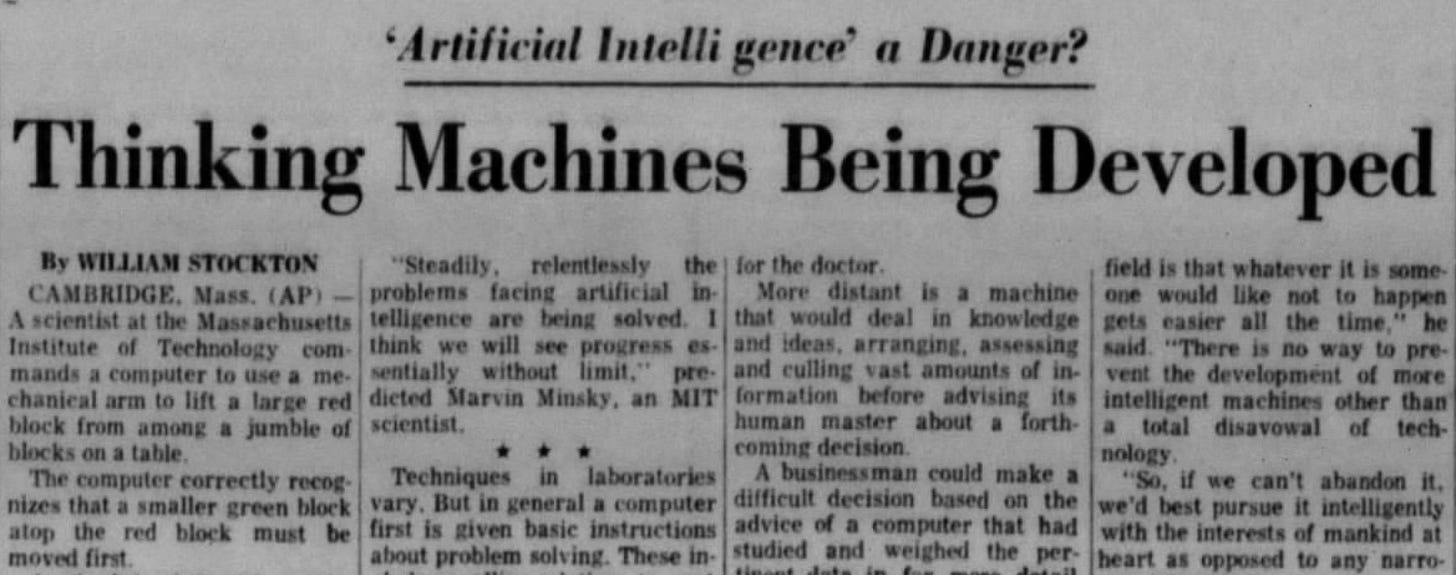🧠🤖 Thinking Machines Being Developed ⚙️🚀
In 1973, William Stockton’s article “Thinking Machines Being Developed” offered a snapshot of AI at the time – both its nascent achievements and lofty expectations. Stockton described early AI experiments that seemed remarkable then: for example, an MIT computer directing a mechanical arm to move colored blocks with basic reasoning, and a mobile robot at Stanford navigating rooms by deciding it must go through a door before completing its task. There was even a program that simulated a paranoid patient’s speech so convincingly that psychiatrists “say the machine is as convincing a paranoid as the humans”. From these modest beginnings, the article projected a future where computers would engage in “independent reasoning”– essentially, machines that think like humans – and help people make complex decisions. The underlying assumption was clear: these “thinking machines” were steadily improving and, given enough time, could attain human-like cognitive abilities. Stockton wrote that “problems facing AI are being solved” and quoted MIT’s Marvin Minsky predicting “progress essentially without limit”.
In hindsight, the article overestimated how quickly AI would reach human-level reasoning. The breakthroughs it highlighted – block stacking and simple Q&A simulations – were real, but progress did not continue “steadily, relentlessly” as Minsky imagined. In fact, soon after 1973, AI entered a period of slowed progress often called the first “AI winter” when grand ambitions outpaced what technology could deliver and funding was cut backen.
It turned out that understanding natural language, common sense, and learning from experience were profoundly hard problems. The article’s faith that thinking machines would simply keep improving missed the coming obstacles, many of which took decades to overcome. Even today in 2025, we still haven’t achieved a true general AI that thinks exactly like a human.
Yet Stockton’s piece wasn’t simply naive; in fact, it got several things right.The article correctly foresaw computers moving beyond mere number-crunching to more intellectual tasks. This has indeed happened: modern AI systems perform tasks like medical diagnosis and strategic planning support, essentially what Stockton envisioned when he wrote that a “doctor could treat a patient on the advice of his computer” and a business executive could rely on a computer’s analysis.
Today’s society grapples with AI-enabled mass surveillance and authoritarian tech abuse, just as the 1973 article cautioned. Stockton gave a concrete scenario of “speech recognition computers” monitoring phone calls for forbidden words. One of the scientists he cited, Joseph Weizenbaum of MIT, was so alarmed by such possibilities that he refused to continue speech recognition research, urging others to halt as well. Another AI pioneer, Edward Fredkin, argued that a moratorium wasn’t realistic: “There is no way to prevent the development of more intelligent machines other than a total disavowal of technology,” he said. “So, if we can’t abandon it, we’d best pursue it intelligently with the interests of mankind at heart.” This debate captures a nuanced view in the article – an understanding that AI’s advance carries risks, but outright avoidance was not the solution.
A contemporary AI researcher reading this article today sees both how far we’ve come and how certain themes remain constant. The article’s belief that AI would keep improving and profoundly benefit society resonates with the achievements of machine learning we witness now. The call to pursue AI “with the interests of mankind at heart” rings true as we grapple with AI ethics and regulation today. In 1973, people were just beginning to comprehend what thinking machines might mean for humanity. Stockton’s piece captured that mix of wonder and worry. From a modern perspective, we can appreciate how it overestimated the short-term and underestimated the complexities, yet it correctly identified enduring questions. The hopes, concerns, and calls for caution voiced in the article echo in today’s discourse, proving that even as the technology evolves beyond anything imagined in 1973, our collective aim remains to harness “thinking machines” for the common good and not let them become our undoing.


